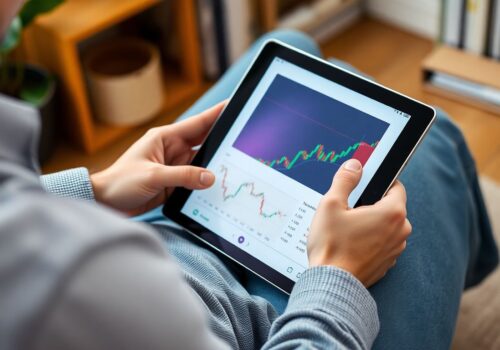Trading Bots: Why They Aren’t Always the Perfect Solution
In the rapidly evolving landscape of cryptocurrency, trading bots have emerged as a hot topic of discussion. As digital currencies like Bitcoin and Ethereum become mainstream, many traders are turning to automated software to optimize their trading strategies. At first glance, these bots offer numerous advantages: they promise efficiency, emotion-free trades, and round-the-clock operations. Yet, as alluring as they may sound, it’s essential to remember that they don’t necessarily fit everyone’s needs. Like any tool, they have their strengths, but they’re not a universal panacea. As we delve into the world of trading bots, we’ll uncover why they might not always be the perfect solution for every crypto enthusiast.
What Are Trading Bots?
In the realm of finance and particularly in the burgeoning cryptocurrency market, trading bots have carved out a significant niche. But what exactly are they?
Trading bots are automated software solutions designed to execute trades on behalf of an investor. Relying on complex algorithms, these bots analyze market conditions, price movements, and other essential data points to decide when to buy or sell a particular asset. The primary allure of such systems is their ability to process vast amounts of information at lightning speeds, far outpacing human capabilities.
These bots operate based on predefined or customizable parameters set by the trader. For instance, a trader might program a bot to sell a particular cryptocurrency if it drops below a specific price or buy more if a certain bullish trend is detected. This level of precision and speed allows for optimized trading strategies, especially in the volatile world of crypto, where prices can fluctuate wildly within minutes.
Typically, trading bots are applied in high-frequency trading, scalping, or even just to automate a long-term investment strategy. They can be integrated into various trading platforms and can be tailored to suit different risk profiles and investment goals.
In essence, trading bots represent the confluence of technology and finance, offering a technologically advanced approach to navigating the intricate and often unpredictable world of cryptocurrency trading. However, as with all tools, they come with their own set of advantages and limitations.
Why Traders Use Bots
Cryptocurrency markets, with their wild price swings and round-the-clock trading, present unique challenges and opportunities. In this dynamic environment, trading bots have emerged as invaluable tools for many traders. Here’s why:
- Speed and Efficiency: In a market where seconds can mean the difference between profit and loss, trading bots excel. They can process vast amounts of data and execute trades in milliseconds, ensuring traders don’t miss out on fleeting opportunities.
- Emotion-Free Trading: Human emotions can be a trader’s worst enemy. Fear and greed often lead to impulsive decisions, such as panic selling or overzealous buying. Bots, being devoid of emotions, make decisions based solely on data and logic, removing the emotional component that can sometimes cloud judgment.
- Consistent Strategies: Bots operate based on predefined algorithms. This means that they can consistently and tirelessly execute a trading strategy, ensuring that the plan is followed to the letter, even when market conditions become highly volatile.
- 24/7 Trading Capabilities: Unlike traditional markets, crypto markets never sleep. For human traders, it’s impossible to monitor these markets continuously. Bots, however, can trade 24/7, ensuring no opportunities are missed and that the trader’s strategy is always in play, regardless of the time of day.
In summary, trading bots, with their blend of speed, consistency, and round-the-clock operations, offer traders a technological edge in the fast-paced world of cryptocurrency. However, while they present clear advantages, they aren’t without their challenges and limitations.
The Downside of Automated Trading
While trading bots offer undeniable advantages, leaning entirely on automation can have its pitfalls. Understanding these limitations is crucial for any trader considering the integration of bots into their strategy.
- As Good as Their Programming: Bots are not sentient; they strictly follow their coding. If there’s a flaw in the algorithm or if it isn’t equipped to handle a particular market anomaly, it can lead to undesired outcomes. They don’t “learn” from mistakes in the same way humans do.
- Market Unpredictability: The cryptocurrency market, often driven by news events, sentiment, and sometimes even pure speculation, can be wildly unpredictable. A bot might struggle in highly unusual market conditions that it hasn’t been programmed for. For instance, if a sudden piece of news creates a massive surge or drop, the bot might not react optimally unless it has been specifically coded for such scenarios.
- Technical Glitches: Technology isn’t infallible. Server downtimes, connectivity issues, or even small software bugs can impede a bot’s functionality. A technical hiccup at a crucial trading moment can result in significant losses.
- Over-Reliance Can Be Risky: Some traders, enamored by the allure of automation, might become overly dependent on their bots. This can lead to complacency and a failure to manually oversee and adjust strategies in changing market conditions.
- Potential for Exploitation: In the ever-evolving world of crypto, new strategies and tools are continually emerging. Some malicious actors design bots to manipulate markets artificially, which can adversely affect other traders.
In essence, while trading bots can be powerful tools, they aren’t magic bullets. Their effectiveness hinges largely on their programming, the reliability of the underlying tech infrastructure, and the ever-volatile nature of the crypto market. As with all tools, a blended approach that combines automation with human oversight tends to yield the best results.
Lack of Emotional Intelligence
One of the most notable differences between human traders and trading bots lies in the realm of emotional intelligence. While the data-driven approach of bots offers the advantage of emotion-free trading, it also comes with a significant blind spot: the inability to gauge and act upon emotional market drivers.
- Market Sentiment: Bots can analyze price movements, trading volumes, and other tangible metrics, but they struggle with understanding market sentiment. When traders collectively feel optimistic or pessimistic about a particular asset, it can drive price changes. These shifts, often rooted in human emotions, can be elusive for bots to predict or respond to effectively.
- Human Intuition: Experienced traders often have an intuitive feel for the market, built over years of experience. They can sense when a trend doesn’t “feel right” or when market sentiment is about to shift. Bots, limited to their coded algorithms, lack this intuitive edge.
- FOMO and Panic Selling: Events like FOMO (Fear of Missing Out) or widespread panic selling are emotionally charged market phenomena. While algorithms can be programmed to detect rapid price changes, understanding the emotional triggers behind such events is beyond a bot’s capability.
In essence, while bots are adept at processing vast amounts of data quickly, they cannot replicate the nuanced understanding and intuition that human traders bring to the table, especially when emotions drive the market.
Dependence on Algorithms
The allure of trading bots largely stems from their algorithmic precision. Yet, this very reliance on algorithms can sometimes be their Achilles’ heel. Here’s why:
- Algorithmic Flaws: No algorithm is perfect. Even the most meticulously crafted ones have their blind spots or can sometimes misinterpret market data. If traders place undue trust in these algorithms without oversight, it can lead to suboptimal trading decisions.
- Unforeseen Market Conditions: Algorithms are designed based on historical data and patterns. However, the financial world is notorious for its unpredictability. Black swan events – unexpected, rare occurrences with significant impact – can throw off even the most sophisticated bots. Such events can lead to sudden market shifts that an algorithm might not be prepared to handle.
- Reactive, Not Proactive: Most trading algorithms are reactive; they respond to market changes rather than predicting them. When unexpected news hits the market, human traders can make judgments on potential outcomes and adjust their strategies proactively. Bots, on the other hand, might only react once the market starts showing tangible shifts.
In sum, while algorithms offer precision and consistency, over-reliance on them without human oversight can be risky. Markets are dynamic and ever-evolving, and a balance between algorithmic efficiency and human judgment is crucial for successful trading.
Cost Implications
Opting for automated trading isn’t just about weighing potential profits against risks; there are tangible costs to consider:
- Acquisition Costs: Quality trading bots, especially those with proven track records, often come with hefty price tags or subscription fees. Free options might exist but may lack advanced features or come with hidden costs.
- Maintenance & Updates: As markets evolve, so should the bots. Regular updates are crucial to keep them in sync with current market conditions. These updates, whether bought or developed in-house, can incur additional expenses.
- Hardware Costs: Running a bot requires robust and reliable hardware. Especially for high-frequency trading, traders might need to invest in powerful servers or cloud-based solutions to ensure optimal bot performance.
In short, while trading bots can potentially amplify profits, traders must factor in the ongoing costs of acquisition, maintenance, and infrastructure when considering their ROI.
Conclusion
The allure of trading bots, with their promise of precision, efficiency, and round-the-clock trading, is undeniable. They represent a fusion of technology and finance, providing traders with tools that can potentially optimize their strategies in the volatile world of cryptocurrency. However, as we’ve explored, these bots come with their own set of challenges and limitations.
Their effectiveness hinges not just on technology but on their programming, the ever-changing nature of markets, and external factors beyond their control. Over-reliance on algorithms without the balance of human judgment can lead to unforeseen challenges.
For traders venturing into the realm of automated trading, the key lies in making informed decisions. It’s essential to do thorough research, understand both the strengths and weaknesses of trading bots, and perhaps most crucially, never lose sight of the need for human oversight. In the end, a harmonious blend of automation and human intuition is likely to yield the most fruitful trading outcomes.
FAQs
Trading bots operate using sophisticated algorithms that analyze market data in real-time. By processing price movements, historical trends, and other relevant indicators, these algorithms generate trading signals, guiding the bot to execute buy or sell orders on behalf of the trader. In essence, they transform vast amounts of market data into actionable trading decisions, often in milliseconds.
No, not all trading bots guarantee profitability. While a bot’s efficiency depends on the strength of its underlying algorithm and strategy, external factors like market volatility can influence outcomes. A bot’s success is also contingent upon the accuracy of its programming and its adaptability to changing market conditions. It’s essential to understand that while bots can optimize trading, they don’t guarantee profits.
Using trading bots comes with several risks:
System Failures: Technical glitches or connectivity issues can disrupt a bot’s operations.
Scam Bots: The market has its share of fraudulent bots designed to siphon funds or manipulate trading.
Market Unpredictability: Bots can struggle in erratic market conditions not accounted for in their algorithms. This makes them vulnerable to sudden, unexpected market movements or black swan events.
It’s crucial for traders to remain vigilant and regularly oversee their bot’s activities.





